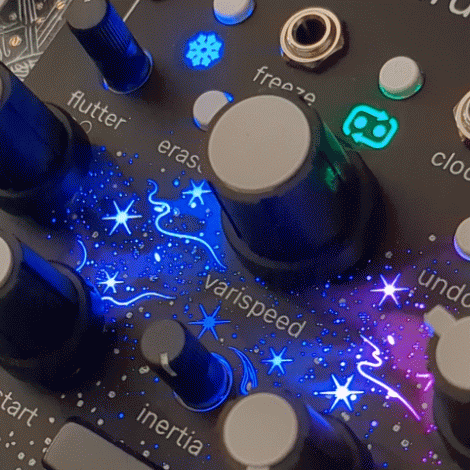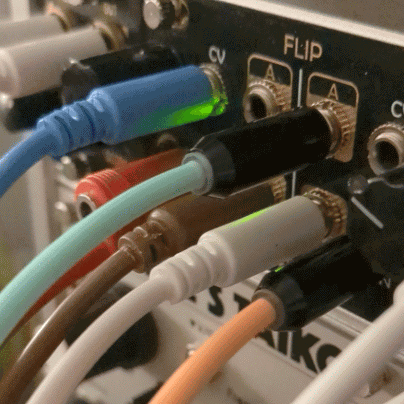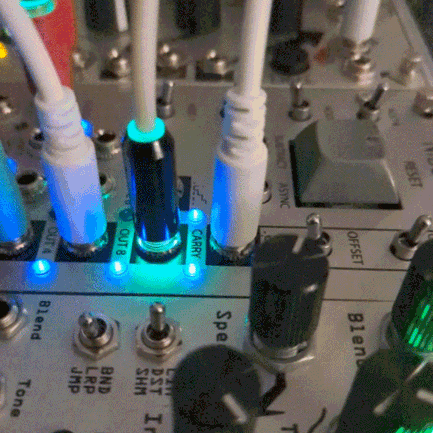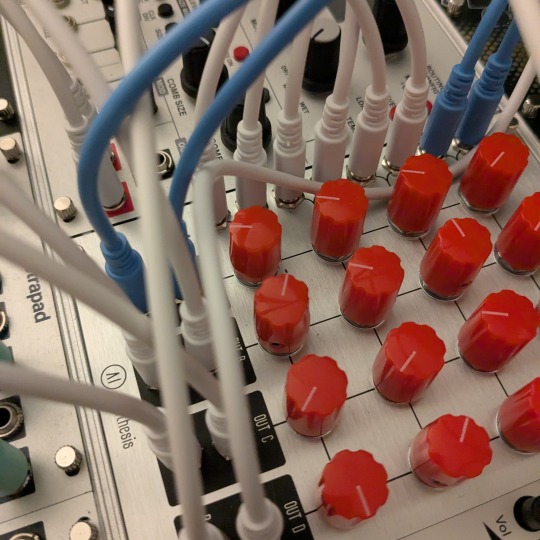I am a 26 year old artist currently living in Chicago, IL. Find here my multimedia art, primarily music. OC only here, personal blog @ivynow
Last active 2 hours ago
Don't wanna be here? Send us removal request.
Text
youtube
Something pretty and simple, mostly seeing if this works!
5 notes
·
View notes
Text
EP release!
Happy solstice! This is a collection of motifs i explored in depth from the first half of this year, broadly within the ambient genre. The release explores in-depth a few minimal composition techniques in distinct permutations performed on eurorack modular synthesizer.
#ep release#ambient music#electronic music#my music#eurorack#modular synth#ambient#bandcamp#Bandcamp
6 notes
·
View notes
Text

I WILL be back soon. Performance Sunday @ Sound Market @ Experimental Sound Studio in Chicago as _w/o_. EP out 6/20/25 on bandcamp. Single is imminent.
Then, back to sketches and demos! And learning the Solar 42f and Scrooge more fully!
13 notes
·
View notes
Text

Sketchbook - revisiting dual looper patch.
9 notes
·
View notes
Text

Copies and copies and nothing else.
There have been a few patches in the last few days where I've learned some interesting techniques but employed them towards very muddy ends, so those will probably live in storage forever. I've been slowly wrapping my head around things, especially using stereo utilities like Prox, Silhouette and Cold Mac in conjunction with LFOs and Vice Virga to create a constantly moving, interesting image.
Besides that, I took the time to read the full Nibbler manual instead of just the quickstart, and I have a better grasp of how to utilize it now - especially how they interact when crosspatched. I'm using the gate and stepped outputs to control all sorts of different parts of a patch, giving a longer structure that can be reorganized for lack of a better word by flipping switches. Multimod is also just being used as a clocked 8x LFO to great effect.
So more broad modulation aside, there are three parts:
Steady voice of three body pluck + drone into Silhouette, modulating the delay for bubbles again.
Pluck from Marbles in ratio mode with nibbler modulating T Bias, multed into DLD at two polymetric divisions, then those mixed together in Prox, with the two DLD channels swapping stereo positions via Vice Virga, then all through Desmodus.
Swell controlled with 0-ctrl pressure mixed into Prox as well.
Another satisfying result with just this case (although I think some percussion would rule here, I've been having some Scrooge issues, figures), I think I may try a little more patching before returning to practicing longer performances on the texture case.
10 notes
·
View notes
Text

Silhouette first patch.
I've been doing a lot of planning, a bit of reorganizing, and a little playing - life continues to be... what it is. In the immediate sphere, it's good things!
As is always the struggle, I'm trying to carve out more time for working on art and music. I've made a lot of changes to the "synth voice" case, getting rid of a lot of stuff that didn't fit my workflow and adding in some shiny new toys. I want to get to know this new system better, to decide if it works - the drum and texture cases feel like they have strong direction.
I'd asked before, if I want to put more finalized ideas on other platforms, what's my blog for? And I think the answer is that, every time I sit down, I should have a recording, and I should post it. Not that they'll all be good, or even listenable, but to be able to revisit what I've experimented with as part of the learning process - the same way you might flip through your old sketchbook, and find value in something you thought of as a throwaway before.
Anyway, this patch itself is using the bones of something from the weekend, that I didn't record - that A/B AR/Bouncing Ball envelope, with the initial attack and bouncy tail processed differently. The pluck here goes through DLD, crosspanned by Cold Mac; and the full sound through Silhouette which is receiving an envelope into focus (creating the bubbly sound) and a sequence into spot - there are a few other plucks going into other inputs for overlapping rhythms when spot is modulated.
Love this thing, I think rhythmic modulation of its parameters coupled with more intentional DLD use is the rhythmic core I was missing for this case. We'll see!
15 notes
·
View notes
Text
youtube
Continuation.
A little something different, as any AV content is increasingly important and it's inconvenient to do direct uploads of longer jams. Planning to do a mix of direct uploads and linked video, though if YouTube becomes more of a place for less finished works, direct uploads might become bandcamp embeds instead.
I'm developing this patch for the first release under my developing project, _w/o_. More videos to come soon.
8 notes
·
View notes
Text

Calmer, more put-together patch expanding on the fundamentals of last time.
I think I need to move Rainmaker elsewhere in the signal chain to add a little more rhythm (right now it's just acting as a comb filter on the chords, which is a little overkill given the wavetable harmonics and QPAS resonance), but this patch is getting quite close to where I want it to continue as a Project.
On that note, I do muse about the possibility of switching out the 4x4 stereo matrix and perhaps traffic as well to make room for Addac's 6x6 mixer. With 4x4, I'm making some compromises - using effects as entry points for sound sources instead of being able to have fx enter the mixer on their own and having all fx within the loop. I think traffic would have to go into the drum case then (perhaps more fittingly) as I couldn't bear to lose it entirely. I'll have to see as I keep recording - how much needs to stay patched and how much can I afford to repatch song-to-song?
Finally, the inertial tape start/stop is such a corny way to bookend a song, but it sounds so good. I can definitely appreciate using it once or twice...
#eurorack#modular synth#flashing gif#tech aesthetic#synthesizer#ambient#ambient music#electronic music#my music#artists on tumblr#patch notes#lo fi music#noise#experimental music#dronemusic
27 notes
·
View notes
Text

The start of something.
The journey has begun on a more formal ambient project, mainly using the texture case but there will be some auxiliary gear used. Small jam here, less to be a full song and more taking a snapshot of patching and testing from tonight, as there are a few more modules I want to work into it.
Main idea is playing Chord and Just Friends (mostly) manually and using Nebulae and Stardust as dual tape loops to create a bed of sound, which can then be rearranged and transformed over time, while also allowing scrubbing into and revisiting of older-performed material. Definitely suited for longer-form performances, of which I want to try recording a few of as well. The dual goals are to really use this as a bed of sound beneath slightly more driven, shorter tracks, and also to be able to use it for a few longer drone pieces and performances as well.
This was the intent of the case, and something I've meant to work towards for a while now, so I'm quite happy to have gotten this configuration working! More to come (very) soon!
#eurorack#modular synth#synthesizer#technology#cybercore#tech aesthetic#industrial music#artists on tumblr#my art#my music#technomusic#ambient#ambient music#electronic music#chiptune#patch notes
15 notes
·
View notes
Text

Decentralized sequencing.
The core of this sequencing was the idea to "strum" Floom by taking an offset into Vice Virga then using an offset to quickly send it through multiple outputs in series. I couldn't quite get it right this time but want to go back to that idea! What I found as I was tuning it though was that, a bit slower, rotating the gates and triggers to different JF voices sounds really nice, and I can generate new sequences using the random mode Adv and Offset of VV independently! So that's the main voice, with a bit of Bib and Data Bender spice.
Percussion is simple - I have a steady ABD kick distorted through MinEQ, Archer's Rig triggered by the "spare" VV outputs through Mum M8, all through Ikarie as I love to do.
Finally, I have a 2OP PM patch from Three Body through an LPG, then both sides of DLD and finally Prism configured like a resonator.
Since the random VV sequences are mostly so pleasing, I literally had just the base of this on in the background for hours yesterday and today before setting on what final bits to add. Really lovely!
#eurorack#modular synth#synthesizer#technology#cybercore#tech aesthetic#industrial music#artists on tumblr#my art#my music#technomusic#ambient#ambient music#electronic music#chiptune#patch notes
24 notes
·
View notes
Note
It looks like those light-up patch cables you're using are the MyVolts Halos(?)
If thats the case, how have they been treating you? And does the visual feedback add anything to your workflow?
Well spotted! I actually have a lot of thoughts on them, so below the break:
The cables themselves feel very nice and sturdy. They have a nice ridgitidy to them, and I haven't yet had any fail in the two years or so that I've been using them.
The visual feedback is handy in some cases. I mute and unmute signals a lot as a performance technique, so it helps me keep track of which are enabled without having to look at the source and figure out which channel it is on the fly. This is especially relevant after a tidbit audio mute toggle (which I use in patches all the time and highly recommend) where I don't have any other indication of whether the switch is engaged or not.
Before I had an oscilloscope, they helped me learn more about how Cold Mac worked as well - if you have any complex modulator without its own LEDs, it can make them a whole lot easier to understand.
Now, for the bad:
While the LEDs do only use a little voltage, it can have noticeable effects. I wouldn't use them for a pitch sequence with a range over 2-3 volts, or I find the higher notes fall a little flat. Even for triggers, I've experienced issues with more sensitive modules like IDUM or Bard Quartet not accepting them. I also find that if I attenuate a signal pre-Halo, the signal will often not usefully light the LED, kind of defeating the purpose.
They also cause problems with some analog modules. Off the top of my head, my Maths functions often get stuck high if km using a Halo on the output.
TLDR, I think they're a useful tool to have in your arsenal, but I wouldn't want them to be my only cables. (and honestly, if your buying more expensive cables with extra features, I'd first opt for TipTop Stackcables.)
7 notes
·
View notes
Text

Finer-tuning that distorted FM sound from years back.
The modular experience is doing something cool by accident once, years ago, then trying to re-create it intentionally. I love this lead, Akemie's Taiko through a pedalboard's worth of processing (EQ, distortion, filter, EQ, compressor). I think the intention was always for Taiko to have the opportunity at a double-life between weird percussion and lead, and I've been finding that happy place a lot more reliably lately.
I'm using a lot of other grit here between other EQs, filtered noise, and sputtering feedback, against a backdrop of the clean Taiko signal through Erbe-Verb. I think a few times it gets a little out of hand, and the overall volume is all over the place throughout the recording.
I set up some fun macro modulation with Cold Mac, with very slow modulation from Maestro controlling 5 outputs including Data Bender mix, causing the glitchy noise swells. I think a bit of slew so this didn't drop off so abruptly would have been good, but overall it's a well-surveiled patch. I tried to adjust the base offset of Survey throughout, to mixed results - in the future I think it'd be nice to mix a sequence with the voltage chain to make it more consistent and even more dynamic (especially since 0-5v can't cover the whole range (but I'm just realizing I could have used Maestro as a bipolar -5-5v source, oops!))
I'd initially wanted to include more of the texture case - Pam is a start button, Bib is the faintest bit of reverb, and I'm using noise sources...that's it. I got too late and I was caught up in the sound design. I don't think that's necessarily a bad thing.
#eurorack#modular synth#synthesizer#flashing gif#gif#cybercore#tech aesthetic#industrial music#artists on tumblr#my art#my music#glitch art#glitch music#technomusic#noise#patch notes#electronic music
38 notes
·
View notes
Text

I live in a post-Magneto world and I'm better off for it. Three variations of the same patch.
Jamuary was a bit of a flop this year for me. Life is so busy, the world is so *gestures vaguely*, I've taken on new responsibilities between my nonprofit and the cat, and on top of all that SAD hit me like never before. I'm honestly surprised that I got 14 out.
As things (hopefully) improve somewhat, I do want to record more. I've been getting lots of small practice in on the XY, and re-re-planning a lot of modular things, and been so motivated to play more.
I've made the first part of a larger spread of changes to the synth case. This patch is exploring those, using Nibbler for a lot of rhythm sequencing/performability and DLD for texture. I was concerned with it having such little character on its own, but with some careful choice of the envelope feeding into it, I find it already gives a good amount of space coupled with Prism. I may not need a dedicated reverb after all. The third of these jams (recorded first) used the Korg NTS-1 for reverb and delay but I didn't feel they were necessary - nor was Daiko, the inherent rhythm is enough to make the patch feel coherent.
I'm looking forward to getting to know the changes thus far a bit better to finalize those in the works. Meanwhile, the other two cases I'm finding very solid and well-rounded already. Good work me.
#eurorack#modular synth#synthesizer#technology#cybercore#tech aesthetic#industrial music#artists on tumblr#my art#my music#echnomusic#ambient music#electronic music#chiptune#technomusic
25 notes
·
View notes
Text

Late is better than not at all.
Took the texture case on the road - mostly pretty here, but a little sloppy. Didn't have time for a lot of takes. Loop from Tetrapad/Just Friends into effect matrix. There's one awkward pause from where I was moving the loop window around - but what can you do.
#eurorack#modular synth#synhesizer#technology#cybercore#tech aesthetic#industrial music#artists on tumblr#my art#my music#ambient music#technomusic#electronic music#jamuary
18 notes
·
View notes
Text

Trying to do something that isn't just driven industrial with the percussion case.
I keep wanting to go more tonal/drone with Worm and getting distracted. Honestly, the main part of this patch is an evolution of yesterday's Akemie stabs, just more drawn out and more distorted. I think a little more modulation on them (probably by way of Ikarie) would have been nice, but they're very pretty.
Overall, just nice percussion going a long way here. Also using Axys to fade between parallel fx on the whole mix: delay from Milky Way and Data Bender to move things along in a nice way.
I want to dive down more this path - even though each case is focused, I want to be able to express a range with each. This also has me considering every HP in the case as I look for more ways to add movement and depth to each voice. If module selection and Jumble Henge are already going a lot of the way towards my mixing, do I really need a MinEQ for each voice? I'm starting to think more and more that I hay have been too hasty. Probably 1-2 small filters with an input or two would take me more of where I wan to go. We'll see! Definitely not against them, but they have not been as transformative as I'd hoped.
#eurorack#modular synth#synthesizer#flashing gif#gif#technology#cybercore#tech aesthetic#industrial music#artists on tumblr#my art#my music#ambient music#technomusic#electronic music#jamuary
12 notes
·
View notes
Text

Blown-out everything.
Back to the drum case after proposed changes: Daiko, Versio, and a MinEQ are out; Golden Master, Mum M8, Axys, and Erbe-Verb are in. This brought me an emergent use for Waver, which was already some nice parallel distortion: a mono send for Erbe-Verb with more playable level control. Very nice.
Mum does sound great on Worm, although it was overshadowed in this patch and I used it in the least dynamic way - though the resonance is allowing Worm's growls to sound much more formant-y than they do on their own. I'll come back to it in the next few days, and let it be front and center.
Axys was pretty much just used as a submixer here - but hey, that flexibility is one of the main reasons I wanted it. I'll do some more creative things with it soon.
Golden Master is wonderful end-of-chain, although I'm open to trying it out more creatively in the middle of everything as well. The band cut buttons are very performable, classic sound.
Using OP-XY for very basic sequencing duties (little bass arp in the beginning, and chimes throughout) as I get used to using it. Joyous little thing, really. I'm using Guillotine as a pre-amp, then running it through Ikarie. I may want a clean input eventually, but honestly, the tape-like overdrive through this method and the mono inputs I have available (Strega, Spectravox)should give me a wide range. I'll need to see how much I want the audio integrated with my modular effects vs mixing it later down the road once reassess standalone mixers.
Last exciting thing about this jam was the use of Taiko for the stabs throughout. Really nice sound out of it, imo.
#eurorack#modular synth#synthesizer#flashing gif#gif#technology#cybercore#tech aesthetic#industrial music#artists on tumblr#my art#my music#ambient music#technomusic#electronic music#jamuary
16 notes
·
View notes
Text

Expanded Erbecussion
We just got a cat, which is so so exciting, but dang does it cut into your music time when first getting them set up! I was happy to get to sit back down and do a simple little jam tonight.
All the percussion is Erbe Verb getting pinged by the dynamic gate of 0-ctrl - pretty much what I was trying to do the other day, but better. The lead is a nice techno-y PM LPG with Shapes as a wavefolder - it's nice here, but I still think it's on the way out.
0-ctrl is clocked internally as well as by a clock out from Magneto, creating a sort of swing for the whole track.
I tried a handful of different tweaks here; with an additional kick for a while from pinging Spectravox which just didn't sound right to me (another unit on the chopping block, honestly, if it werent a good-enough mic input for now...but eventually...) and across all those settings changes, I actually recorded a take I prefer overall but where I had the PM on Three Body off. I don't know which I prefer better, but I'm getting tired over here, so I've made my choice but opt to post both!
Honestly, something just like the pings at the end of this would be a great basis for another jam - I do love dplpg and Prism with Three Body!
#eurorack#modular synth#synthesizer#flashing gif#gif#technology#cybercore#tech aesthetic#industrial music#artists on tumblr#my art#my music#ambient music#technomusic#electronic music#jamuary
26 notes
·
View notes